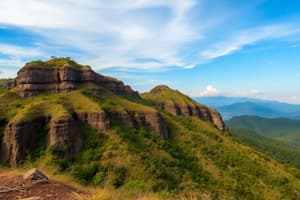Podcast
Questions and Answers
List the four features of Karst Topography.
List the four features of Karst Topography.
Sinkholes, caverns, disappearing rivers, natural bridges.
What makes sediments porous and permeable?
What makes sediments porous and permeable?
Porous - if they are well sorted, they have many cracks; permeable - they are cross-grained, having interconnected cracks.
How does the level of the water table affect wells, springs, rivers and lakes?
How does the level of the water table affect wells, springs, rivers and lakes?
There will not be enough water.
How do caves form?
How do caves form?
How do formations in caves form?
How do formations in caves form?
How long does it take formations to form?
How long does it take formations to form?
What are some unique adaptations of animals that live in caves?
What are some unique adaptations of animals that live in caves?
What causes geysers and springs?
What causes geysers and springs?
Study Notes
Karst Topography Features
- Four key features of Karst Topography: sinkholes, caverns, disappearing rivers, natural bridges.
Sediment Porosity and Permeability
- Porosity refers to well-sorted sediments that contain numerous cracks.
- Permeability involves sediments with interconnected cracks, allowing fluid flow through the material.
Impact of Water Table Levels
- A low water table can result in inadequate water supply for wells, springs, rivers, and lakes.
Cave Formation Process
- Caves form through chemical weathering via carbonation, involving water that dissolves carbon dioxide to create carbonic acid.
- This acid leads to the dissolution of calcite-rich rocks, such as limestone.
Cave Formation Features
- Stalactites and stalagmites develop when water that drips into caves contains dissolved calcium carbonate.
- Upon contact with air, the water loses carbon dioxide, resulting in limestone precipitation.
Timeframe for Formation
- The formation of cave structures takes an extensive period, signifying long geological processes.
Cave-Dwelling Animal Adaptations
- Unique adaptations in cave animals include lack of pigmentation, absence of eyes, infrared vision, heightened movement detection, and echolocation abilities.
Geysers and Springs
- Geysers and springs are natural phenomena caused by geothermal activity but require additional context for detailed explanation.
Studying That Suits You
Use AI to generate personalized quizzes and flashcards to suit your learning preferences.
Description
Explore the fascinating features of karst topography and the cave formation process. This quiz covers topics like sinkholes, caverns, the impact of water table levels, and the formation of stalactites and stalagmites. Test your understanding of these geological processes and concepts.



